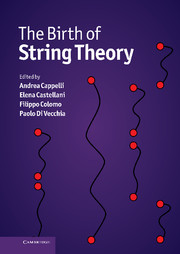Book contents
- Frontmatter
- Contents
- List of contributors
- Photographs of contributors
- Preface
- Abbreviations and acronyms
- Part I Overview
- EARLY STRING THEORY
- Part II The prehistory: the analytic S-matrix
- Part III The Dual Resonance Model
- Part IV The string
- TOWARDS MODERN STRING THEORY
- Part V Beyond the bosonic string
- Part VI The superstring
- Part VII Preparing the string renaissance
- 42 Introduction to Part VII
- 43 From strings to superstrings: a personal perspective
- 44 Quarks, strings and beyond
- 45 The rise of superstring theory
- Appendix A Theoretical tools of the Sixties
- Appendix B The Veneziano amplitude
- Appendix C From the string action to the Dual Resonance Model
- Appendix D World-sheet and target-space supersymmetry
- Appendix E The field theory limit
- Index
45 - The rise of superstring theory
from Part VII - Preparing the string renaissance
Published online by Cambridge University Press: 05 May 2012
- Frontmatter
- Contents
- List of contributors
- Photographs of contributors
- Preface
- Abbreviations and acronyms
- Part I Overview
- EARLY STRING THEORY
- Part II The prehistory: the analytic S-matrix
- Part III The Dual Resonance Model
- Part IV The string
- TOWARDS MODERN STRING THEORY
- Part V Beyond the bosonic string
- Part VI The superstring
- Part VII Preparing the string renaissance
- 42 Introduction to Part VII
- 43 From strings to superstrings: a personal perspective
- 44 Quarks, strings and beyond
- 45 The rise of superstring theory
- Appendix A Theoretical tools of the Sixties
- Appendix B The Veneziano amplitude
- Appendix C From the string action to the Dual Resonance Model
- Appendix D World-sheet and target-space supersymmetry
- Appendix E The field theory limit
- Index
Summary
Introduction
In this Chapter we review the developments of string theory from its renaissance in 1984 up to present times, as a kind of epilogue. We shall be rather brief and omit references to original work that would be unavoidably limited: extensive bibliographies can be found in the textbooks mentioned at the end.
After the mid-Eighties, research in string theory was at the forefront in theoretical physics and had a strong impact in many other domains. Even though its main goal, that of unifying fundamental interactions, has not been accomplished yet, and the chances of success are being debated, we can fairly say that string theory has had a broad and lasting influence on theoretical physics. In short, it changed the way research is done in the field. Over the last 25 years, theoreticians were more keen on using advanced mathematical tools and on resorting to abstract modelling: for example, by playing with the spacetime dimension, i.e. considering a given problem also in dimensions different than four. After being presented in the mid-Eighties as ‘the theory of everything’, i.e. of all fundamental interactions, string theory was later dubbed ‘the theory of nothing’ by its opponents; in recent times, it has also been called ‘the theory for everything’, for its many, often unexpected applications.
New techniques of two-dimensional conformal field theory introduced in string theory were employed to describe low-dimensional condensed matter systems and statistical models.
- Type
- Chapter
- Information
- The Birth of String Theory , pp. 552 - 568Publisher: Cambridge University PressPrint publication year: 2012



